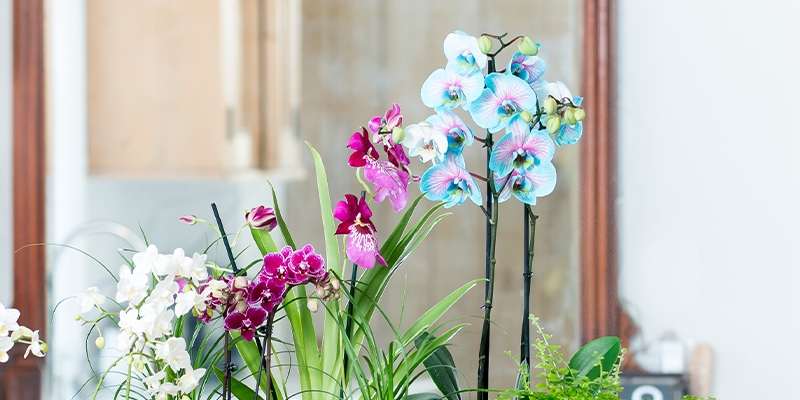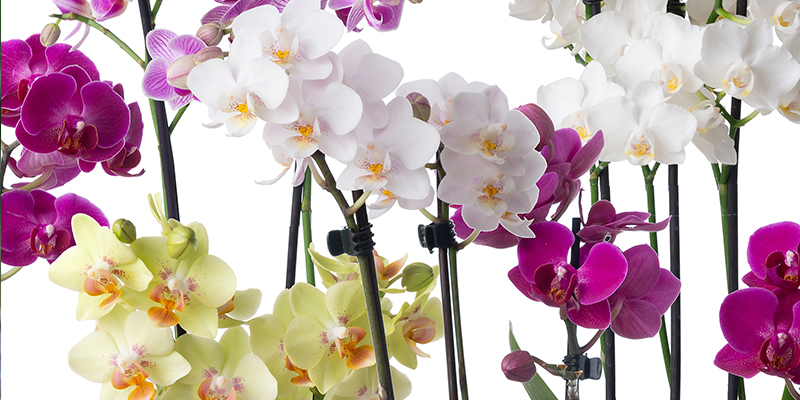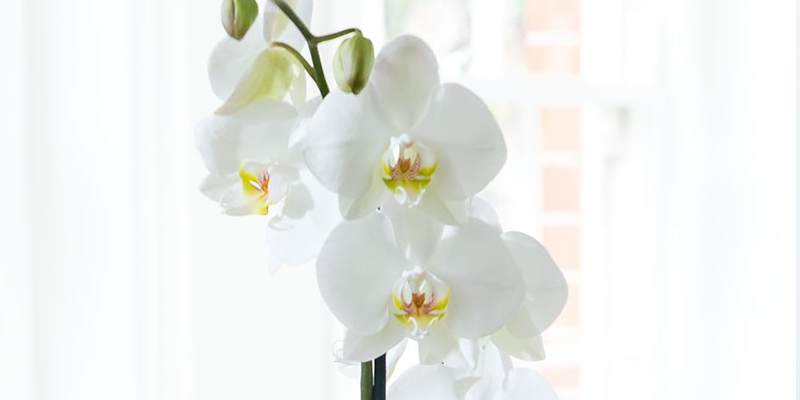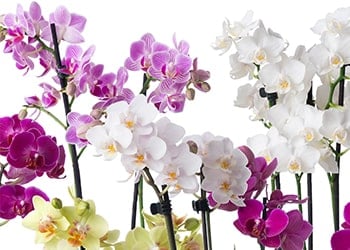
Our useful top tips on how to care for orchids will help you to get the most out of your beautiful plants.
As part of one of the largest families of flowering plants, the orchid has long been a symbol of love and beauty. There are around 28,000 species of orchid, each with their own colourful, fragrant and iconic blooms. They can be as tiny as a penny or up to 1.5 metres high. Every type of orchid has its own needs and requirements, which means helping them thrive isn't always a simple task.
We're big fans of the popular phalaenopsis orchid - it's a great beginner orchid, as it's less finnicky to care for than many other types. Here are our top tips on caring for your phalaenopsis orchid.
Orchid Terminology
Before we get started, here's a quick guide to some of the more common terms you might see us using. If you have no idea what a node or bud blast is, we've got you covered.
Flower Spike
This is pretty much what it says on the tin - it's the part of your orchid's stems where flowers will grow. Each spike will eventually die once it has finished flowering. This doesn't mean your orchid is dead - phalaenopsis orchids will grow new spikes over time.
Orchid Node
Nodes are the slightly raised parts on your orchid's stem. These are the parts that kickstart new growth, so new flowers, stems, and spikes will begin from these. Only a few nodes will be active, as many stay dormant to conserve energy. Typically, older nodes will be the active ones.

Bud Blast
Bud blast is a term used to describe flowers that have prematurely died before or soon after opening. These are usually a sign that something is wrong with your orchid's environment, such as low lighting, too much or too little water, or rapid temperature changes. Read our tips below to avoid a bud blast.
Orchid Needs & Care
Sunlight
Like many plants, phalaenopsis orchids like bright, indirect light - think a east or west facing window. Avoid placing them in direct sunlight for more than a couple of hours a day, as this can burn them.
Bright green leaves are a good indicator that the plant is getting enough light. If leaves start to darken, or your orchid hasn't bloomed in a long time, it's probably not getting enough light.
Temperature & Humidity
Phalaenopsis orchids make great house plants partly because they like being about as warm as we do. They'll be happy with temperatures between 18°C -26°C in the daytime, but need it to be slightly cooler at night to bloom. They don't like the cold though, so temperatures shouldn't be allowed to drop below around 15°C.
Orchids are tropical, so do prefer higher humidity levels than we do. This actually makes them a great plant for bathrooms, as they'll appreciate the extra moisture from steam, as well as the warmer air.
Water
Your orchid's environment will determine how often you should water it - for example, in the summer, the soil will dry out more quickly and your orchid will need watering regularly.
Usually, they'll need to be watered around every 1-2 weeks, but keep an eye on the soil and never let them dry out completely. Overwatering can be equally dangerous, so avoid making the soil waterlogged.

How to Help Your Orchid Rebloom
Orchids can bloom for up to four months at a time, but once they're done, they'll bloom again with some help from you. Flowers will normally appear around once a year in the winter, but they can bloom more often when well looked after. Pruning your orchid correctly can make a big difference.
Pruning Orchids
First of all, always make sure you're using clean tools to prune your orchid. This will help prevent the spread of disease from plant-to-plant and mean a long and healthy life for your orchids.
You'll want to prune your orchid when its existing flowers are dying off. As the flowers fade, carefully cut them away from the stems. Once all the flowers are gone, take a look at the flower spike. If it's green, it's still healthy and can produce more flowers and new spikes. If you want to speed this up a bit, you can trim about 2-3cm above the node that's beneath the lowest flower on the spike. This gives it the chance to create a new side shoot that will flower more quickly than a new flower spike would.
However, if the flower spike has turned brown after flowering, this means the spike has died and won't produce any more flowers. In this case, it's best to cut the flower stem all the way down to the bottom of the plant. This will give your orchid more energy to grow and flower again in the future. If only the top of the spike is brown, simply cut this part away, leaving any green parts intact.
Remember that green, healthy looking flower spikes can still be low on energy - wait until it blooms again to see how it's doing. If its flowers look smaller than usual, it can be best to cut the spike away when it's finished blooming. This will give it the chance to restore its energy for its next flowers.
Temperature Changes
A drop in temperature can also help your orchid to rebloom, as this mimics weather changes that causes them to bloom in the wild. Try moving them to a slightly cooler room to get them started.
Repotting Orchids
Orchids typically need repotting about once a year. This gives them fresh, nutrient rich soil to aid their growth. If the plant starts to look a little worse for wear - for example, if its lower leaves become discoloured, or its aerial roots are escaping the pot - it's probably time to repot yours.
It's best to repot orchids in the spring or summer, but never when the plant is in bloom. You should only move them to a slightly larger pot (around an extra inch in size), and make sure to provide a high quality orchid potting mix.
Read our guide on repotting an orchid for more detailed tips.

Like many tropical plants, orchids can be a challenge to care for. You may find yourself becoming impatient in attempting to parent your orchid to its full potential, but good things come to those who wait – so stay persistent and the results will come!
Whilst you are here, take a look at our at our Orchid flower bouquets or our beautiful Orchid plants range to get your very own or treat someone else to a bouquet by post! We too offer a great range of orchid plants which are available for next day flower delivery.






